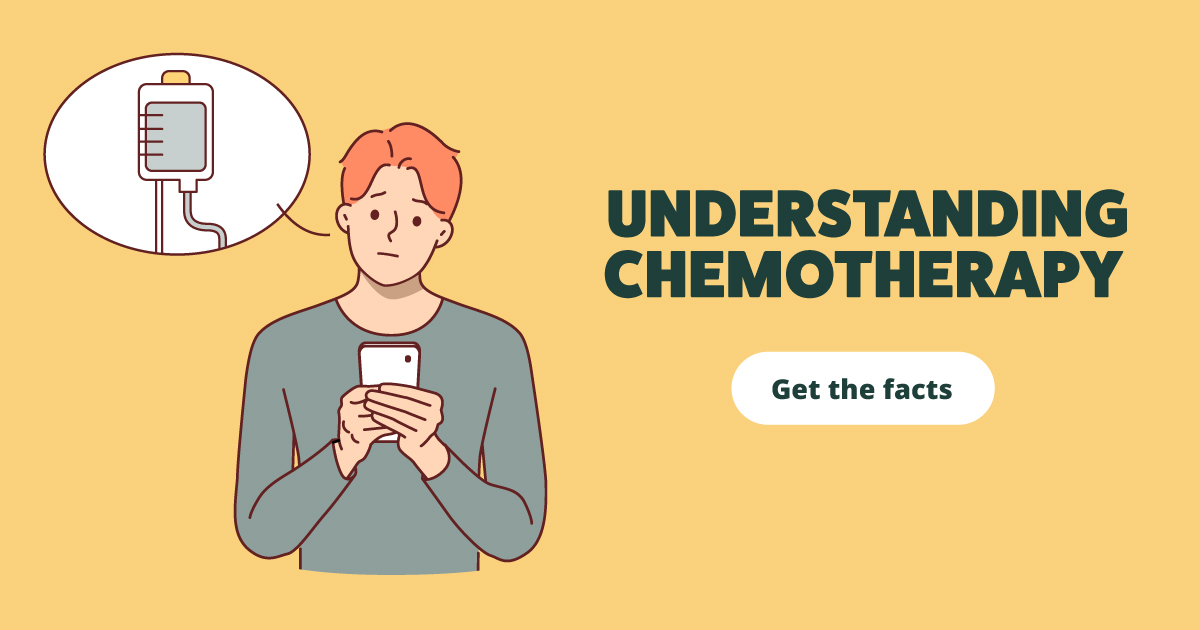Health library
Back to health library
What to know about chemotherapy
Chemotherapy uses powerful medications to destroy cancer cells. If you or a loved one will be starting chemo, learning more about this common type of cancer treatment can help you feel better prepared. Scroll on to discover a few key facts.
It attacks fast-growing cells
Chemotherapy works by killing or slowing the growth of fast-growing cells. Cancer cells grow and divide rapidly, which is why chemo is good at targeting them. These drugs work in different ways, and they're often combined to strengthen their attack on cancer cells. For instance, some chemo drugs change the DNA inside cancer cells to keep them from growing and multiplying.
Chemo can be used to achieve different goals
Chemo can be used to rid the body of cancer and keep it from coming back. Or the goal might be to control cancer by slowing the disease down. Sometimes cancer is very advanced and can't be controlled. In those instances, chemo may relieve some of the symptoms it causes and help a person feel better.
Chemo is a body-wide treatment
The medicine travels throughout your body to kill cancer cells, even those that may have spread away from the tumor. Surgery or radiation are different. They treat a specific area of the body where the cancer was found.
It's tailored to you
Your cancer doctor will decide what drug or drug combinations you will need, and how often and how long you will get treatment. These decisions are based on many factors. These may include the type and stage of your cancer, your overall health, and your medical history.
Chemo is often given by infusion
Most people receive chemo drugs through an IV placed in a vein in their arm or hand. When chemo is given over longer periods, a catheter (called a central line) may be surgically placed in a vein in the chest. This way, you won't have a needle poke each time you get chemo.
In some cases, chemo may be given in pills, injections or creams you put on your skin.
Many people have their chemo in a hospital's infusion center
Or people may go to a doctor's office to receive their chemo. Each treatment session can be a few minutes to a few hours.
Chemo pills (oral chemotherapy) can be taken at home, with special instructions provided by a doctor.
Chemo is given in cycles
A cycle is a period of treatment followed by time off. For example, you might have chemo for two weeks followed by one week off. The rest lets your healthy cells recover. The number of cycles and length of your treatment can vary depending on the type of cancer you have, your treatment goals, the chemo drugs being used and how your body responds to them.
Chemotherapy can cause side effects
Chemotherapy can also destroy some healthy cells, such as those in bone marrow, hair, the mouth and the digestive tract. This can cause side effects such as fatigue, hair loss and vomiting. Everyone responds differently to chemo. Your cancer team can tell you which side effects are likely to occur and how you can help prevent or manage them.
Chemo can weaken the immune system, which can make you prone to infections. Some simple changes can help you reduce your risk.
Reviewed 9/12/2025
Sources
- American Cancer Society. "Chemotherapy Safety." https://www.cancer.org/cancer/managing-cancer/treatment-types/chemotherapy/chemotherapy-safety.html.
- American Cancer Society. "Chemotherapy Side Effects." https://www.cancer.org/cancer/managing-cancer/treatment-types/chemotherapy/chemotherapy-side-effects.html.
- American Cancer Society. "Getting IV or Injectable Chemotherapy." https://www.cancer.org/cancer/managing-cancer/treatment-types/chemotherapy/getting-chemotherapy.html.
- American Cancer Society. "Getting Oral or Topical Chemotherapy." https://www.cancer.org/cancer/managing-cancer/treatment-types/chemotherapy/oral-chemotherapy.html.
- American Cancer Society. "How Chemotherapy Drugs Work." https://www.cancer.org/cancer/managing-cancer/treatment-types/chemotherapy/how-chemotherapy-drugs-work.html .
- American Cancer Society. "How Is Chemotherapy Used to Treat Cancer?" https://www.cancer.org/cancer/managing-cancer/treatment-types/chemotherapy/how-is-chemotherapy-used-to-treat-cancer.html.
- National Cancer Institute. "Chemotherapy to Treat Cancer." https://www.cancer.gov/about-cancer/treatment/types/chemotherapy.
- National Library of Medicine. "Chemotherapy." https://medlineplus.gov/ency/article/002324.htm.
